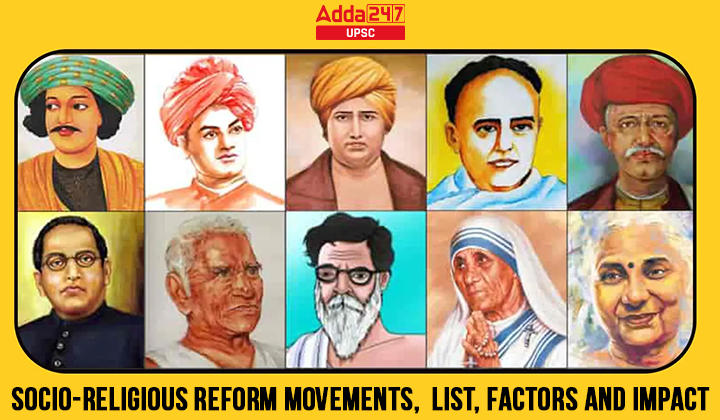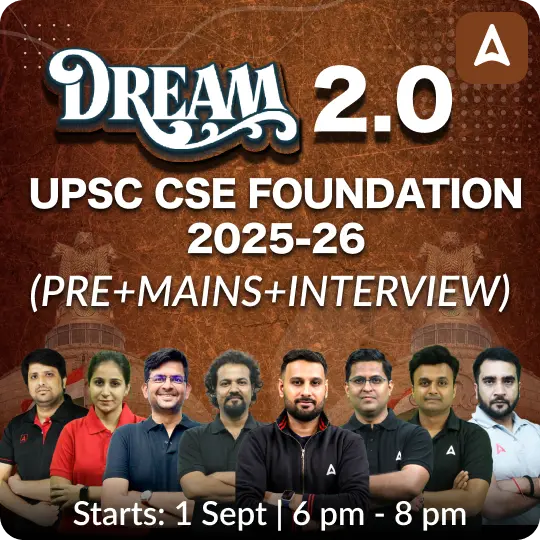Table of Contents
Socio-Religious Reform Movements, List, Factors and Impact: The 19th century witnessed several Socio-Religious Reform Movements carried throughout India aiming to refine and modernize Indian society. The article highlights the list of reforms and the impacts of the socio-religious reforms in the 19th century.
Socio-Religious Reform Movements
The 19th century exhibited a number of Socio-Religious Reform Movements carried out throughout India aiming to refine and revitalize Indian society through social rationalization. The British rule in India during the 18th and 19th centuries made India deficient in several basic social and religious customs. Various drawbacks and lapses were exhibited in the Indian social and religious institutions.
The Socio-Religious Reform Movements and their leaders in the 19th century were identified specifically for the balance between religious and social issues. During that time, a number of people and reformists in the movements worked to bring a significant change in social and religious customs. The leaders of the movement aimed to reform and revive the Indian society positively.
The urgent need for social and religious reform that began in the early decades of the 19th century was mainly due to the influence of Western culture and education. The weakness and decay of Indian society were evident to educated Indians who started questioning the practices and initiated working systematically for their removal. The new adaptations and changes that took place in the Indian social scenario are popularly known as the Indian Renaissance.
In the 19th century, Indian society was rigid, caste-based, and restricted in several ways. India witnessed a series of reform movements undertaken in various parts of the country oriented towards restructuring Indian society along modern lines.
Types of Socio-Religious Reform Movements
The reform movements prevalent in the 19th century in India were categorized as reformist and revivalist movements. Both the reformist and revivalist movements varied from each other as one depended on time and tradition while the other was based on reason and conscience.
| Types of Socio-Religious Reform Movements | |
| Reformist Movements – These movements attempted to bring changes with time into existing institutions along with modern terms. | Revivalist Movements – These movements started reviving ancient Indian traditions, customs, practices, and thoughts to get back India’s great past believing that Western concepts hampered Indian culture and society. |
| Examples of Reformist Movements: Brahmo Samaj, Prarthana Samaj, and the Aligarh Movement. | Examples of Revivalist Movements: Arya Samaj and Deoband movement. |
Factors leading to Socio-Religious Reform Movements
The socio-religious reform movements of the 19th century left their impressions on the centuries to come as an example of social reform and religious revival in the country. The British introduced concepts of the West and modern ideas to India. They developed an understanding of terms like liberty, social independence, economic equality, fraternity, democracy, and justice in Indians reflecting a significant impact on Indian society.
In the 19th century, there existed Socio-Religious superstitions and social obscurantism. Women were miserable and humiliated. Social evils like the killing of female infants, sati pratha, child marriage, polygamy, and sati were also under practice.
The reformers and people became familiar with ancient history, philosophy, religions, and literature and realized to bring reforms against this oppression and practices to maintain their civilization. There was a prevalent mention of nationalism and democracy during such reforms through the spread of education and awareness.
Socio-religious reform Movements and Indians like Raja Ram Mohan Roy, Ishwar Chand Vidyasagar, Dayanand Saraswati, and many others were willing to bring reforms to society to remove the social evils that were hampering the Indian culture and society.
The British rule introduced the concept of freedom of the press in India which enabled to education of society about evil social practices. Indians then began to recognize the defects of their society and came together to think of ways to remove such practices.
Several individuals and reformers of the movements collectively sought to bring changes in social and religious practices with a view to reforming and revitalizing society.
Classification of Socio-Religious Reform Movements
The socio-religious movements in India that took place in the 19th century can be classified on the basis of Religions, namely, Hindu, Muslim, Sikh and Parsi reform movements. Hindu reform movements were held in different locations including East India, West India, South India and North India.
- Hindu Reform Movements – Several Hindu reform movements took place in Eastern India. Bengal was the chosen hub for many reform organizations. Prominent Hindu Eastern movements: Brahmo Samaj By Raja Ramohun Roy, Tattvabodhini Sabha And Adi Brahmo Samaj By Debendranath Tagore, Brahmo Samaj Of India By Keshab Chandra Sen and Young Bengal Movement By Henry Derozio. Another major Hindu reform movement to have its roots in Maharashtra was the Theosophical Society. Religious reforms started in Bombay in 1840 aimed at the caste system. Movements like Prarthana Samaj By Dadoba Pandurang And Atmaram Pandurang, Arya Samaj By Swami Dayanand Dayanand Saraswati.
- Muslim Reform Movements – Many reformers and prominent leaders influenced and brought changes to the Muslim population in India. Reformers and Muslim movements: Sayyid Ahmad Khan and the Aligarh School, Muhammad Iqbal (1876-1938), Wahabi Movement, Ahmadiyya Movement and Barelvi Movement.
- Sikh Reform Movements – Religious reforms among the Sikhs started at the end of the 19th century and gained momentum after 1920 when the Akali Movement arose in Punjab. Prominent Sikh movements: Akali Movement (Punjab), Nirankari Movement, Kuka Movement (Namdhari Movement, 1872) and Singh Sabha Movement (1873).
- Parsi Reform Movements – Religious reforms among the Parsis include various prominent figures: Naoroji Furdonji, Dadabhai Naoroji, S.S. Bengalee and Rehnumai Mazdayasan Sabha Association
List of Social and Religious Reform Movements
Below is the list of social and religious reform movements and the personalities associated with them.
| Organisations | Personalities | Movements |
| Reformist Movements (18th-19th Century) | ||
|
Brahmo Samaj |
Raja Ram Mohan Roy |
Founded in 1828 in Calcutta by Raja Ram Mohan Roy (1772 – 1833). The agendas of the movement were against idol worship, caste oppression, superstitions and other social evils like Sati, purdah system, child marriage, etc.
The notion of the movement was that all religions are interconnected. The first major socio-religious reform movement led to an increase in India’s rationalism and to reform Hinduism. |
|
Aligarh Movement |
Sir Syed Ahmed Khan & Others
|
Sayyid Ahmed Khan founded the movement in 1875 mainly to encourage remarriage of widows, prohibiting child marriages. Founded the Mohammedan Anglo-Oriental College in Aligarh in 1875. Later developed into the Aligarh Muslim University. He led an anti-British movement and offered modern education to Muslims. He was a supporter of practical morality, the fundamental unity that underlies all religions. |
| Prarthana Samaj | Dr Atmaram Panduran | In 1867, Atmaram Panduran found the Prarthana Samaj in Bombay to profess universal brotherhood respecting all religions.
The Prarthana Samaj fought against priestly domination and caste system, practises of sati, and polygamy. Chandavarkar was a great leader of the Prarthana Samaj. The Samaj’s approach focused more on education. |
| Revivalist Movements | ||
| Arya Samaj | Swami Dayanand Saraswati | Swami Dayanand Saraswati (1824-1883) founded the Arya Samaj in 1875.
This society sought to reform Hinduism and fought against sati, polygamy, priesthood, untouchaibilty, animal sacrifice, child marriage and the caste system. They worked for the overall improvement in the condition of women and advocated social equality. |
| Deoband Movement | Muhammed Qasim Wanatavi & Rashid Ahmed Gangoli | Muhammad Qasim Wanotavi and Rashid Ahamad Gangohi founded a school in Deoband (Uttar Pradesh, Saharanpur District) in 1866. It majorly focused on uplifting the Muslim community through religious education. |
| Other Important Movements | ||
|
Theosophical Society |
Madame H P Blavatsky & Col H S Olcott |
Began in Kolkata and was founded by Madame Blavatsky and Colonel Olcott in New York (later shifted to Madras) in 1875. It promoted the study of ancient Hindu and Buddhist philosophies. It fought against child marriage, polygamy and occultism. It promoted the concept of universal brotherhood without discrimination of race , caste, sex or creed. |
|
Ramakrishna Mission |
Swami Vivekanand |
Founded by Swami Vivekananda in 1897 to promote the teachings of Vivekananda’s Guru Ramakrishna Paramahansa and spiritual values to Indians.
It fought against and opposed the caste system and untouchability. It focused on reforming Hinduism by embracing teachings of Vedanta. |
| Satyasodhak Samaj | Jyotiba Phule | This society was founded by Jyotirao Govindrao Phule on 24 September 1873, Maharashtra. It campaigned against idolatry and the caste system and aimed at educating the lower sections of the society. It rejected the priesthood, Upanishads and vedas. Jyotirao Phule used the term ‘Dalit’ for the oppressed castes. |
| Wahabi Movement | Shah Walliulah | Syed Ahmed professed authentic Islam and Arabian culture and rejected Western influences on Islam. Wahabis majorly propagated Anti-British sentiment. The Wahabis faced British military attacks on the Wahabi base at Sithana and numerous court cases alleging sedition against the Wahabis. |
| Ahmadiyya Movement | Mirza Ghulam Ahmed | Islamic revivalist movement of late 19th century was when a Muslim sect called the Ahmadiyya first appeared in India. Mirza Ghulam Ahmad started the movement and described itself as representing the Mohammedan Renaissance. The movement was established and based universality of religions. It believed in renouncing jihad and educating Indian Muslims. |
| Barelvi Movement | Syed Ahmad Rai Barelvi | Syed Ahmad Rai Barelvi was a strong supporter of puritanical extremism and violent jihad. He was first influenced by Sufi groups and silsilas such Naqsyabandiyah, Chishtiya, and Qadriyah. |
| Young Bengal Movement |
Henry Louis Vivian Derozio |
Started by Henry Louis Vivian Derozio in Calcutta in the 1820s. He taught at Hindu College till 1831 and was inspired by french revolution. He professed rationalism and free thinking. He criticised religious practices of orthodox Hinduism. |
Other Important Reform Movements and Personalities
| Movement | Personality |
| Self-Respect Movement | E V Ramaswami Naicker |
| Radhaswami Movement | Tulsi Ram or Shiv Dayal Saheb |
| Social Service League | Narayan Malahar Joshi |
| Seva Samiti | Hridyanath Kunzru |
| The Indian Women’s Association | Annie Besant |
| Dharma Sabha | Radhakant Deb |
| Missionaries of Charity | Mother Teresa |
| Nishkam Karma Math | D.K.Karve |
| Home Rule Movement | Annie Besant & Bal Gangadhar Tilak |
| Bharatiya Vidya Bhavan | Kanhaiyalal Maneklal Munshi |
| People’s Union for Civil Liberties and Democratic Rights | Jaya Prakash Narayan |
| Chinmaya Mission | Swami Chinmayananda |
| People’s Education Society | Dr B.R.Ambedkar |
| Vishwa Bharti | Rabindranath Tagore |
| Bharat Dharma Mahamandalas | Madan Mohan Malviya, Deen Dayal Sharma, Gopal Krishna Gokhale |
| Abhinav Bharat | Veer Savarkar |
| Chipko Movement | Sunderlal Bahuguna |
| Narmada Bachao | Medha Patkar |
| Servants of India Society | G K Gokhale |
| Servants of People Society | Lala Lajpat Rai |
| Servants of God or Khudai Khidmatgar | Khan Abdul Gaffar Khan |
| Van Mahotsav | K M Munshi |
| Bhoodan Movement | Vinobha Bhave |
| Tattvabodhini Sabha | Debendranath Tagore |
| Dadoba Pandurang | Paramhansa Sabha |
| Seva Sadon | Behramii M Malabari |
Impact of Socio-Religious Movements
The socio-religious movements in India impacted in both ways, positive and negative. These impacts affected society largely on various levels.
Positive Impact of Socio-Religious Reform Movements
- The backward and orthodox sect of the society was unable to accept the changes brought by the reformers. People belonging to this segment reacted, insulted, and issued fatwas against the reformers, and even attempted to assault and kill them. However, despite this rejection, the reformers continued and were able to help people become free and fight against all oppressions.
- People who believed in their religion started to think with open minds that their faiths and culture were decadent and inferior. Due to certain movements, religious believers developed reasonable thinking and eliminated corrupt practices from religion.
- The religious reform movements developed a sense of unity. They opposed the superstitious, irrational and obscurantist elements of Indian religion.
- The religious reform movements helped many Indians to recognize and accept the modern world with full understanding. These movements led to the emergence of Indian nationalism and independence.
- The reforms enabled women to have an education, removed women from purdah, prohibited monogamy, and introduced employment options for women in private and public sectors. These reforms specifically for women led to their significant participation in India’s battles for independence.
- The reform movements enabled the middle classes to fight back against humiliation and suppression.
- Some legal measures were initiated, Sati was banned in 1829 and Infanticide was made illegal. Another legislation approved widow remarriage in 1856. In 1860, the marriageable age of females was changed to 10 and Inter-caste and inter-communal marriages were legalized in 1872 by legislation. In 1891, another law was passed to prevent underage marriage. Further, in 1929, the Sharda Act was passed to prevent child marriage.
Negative Impact of Socio-Religious Reform Movements
- The reforms only catered to the urban middle and upper classes and a huge percentage of peasants and urban poor were ignored.
- There was a constant approach to the past of the nation i.e. the urge to glorify the greatness of the past which led to the creation of false pride and ignorance to improve the present with full acceptance of modern concepts.
- The nature of the religious reform movements gave rise to communal consciousness within the middle class. Due to these reforms, different segments and sections of Hindus, Muslims, Sikhs, and Parsis were done. Further, they were separated into high-caste Hindus from low-caste Hindus.
Conclusion on Socio-Religious Reform Movements
Socio-religious movements have marked an important stamping in India’s history. The Socio-religious reform movements that took place in the 19th century have led to some major legislations and laws prohibiting illegal and inhumane practices. Every reform movement had its unique impact on Indian society, religious communities and culture.



 TSPSC Group 1 Question Paper 2024, Downl...
TSPSC Group 1 Question Paper 2024, Downl...
 TSPSC Group 1 Answer key 2024 Out, Downl...
TSPSC Group 1 Answer key 2024 Out, Downl...
 Cabinet Ministers of India 2024, New Cab...
Cabinet Ministers of India 2024, New Cab...







